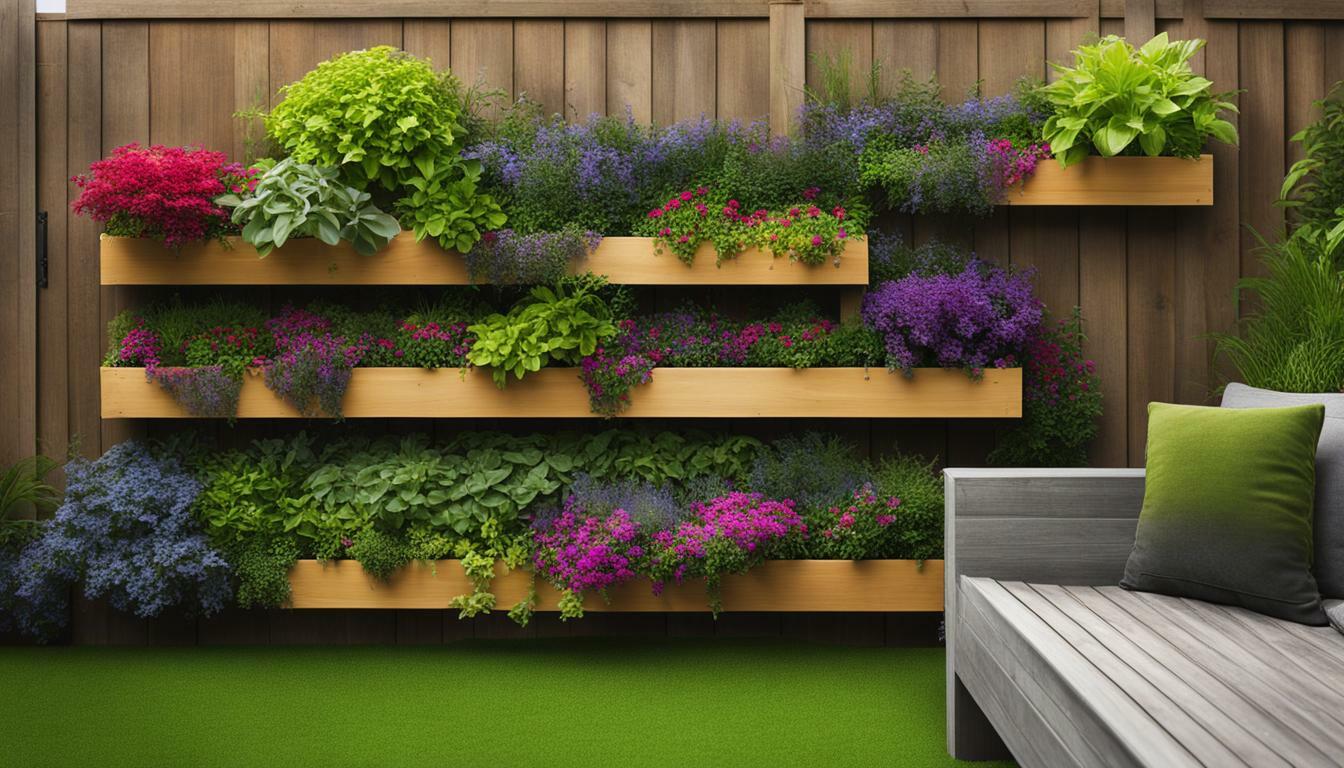- Building a trellis on the fence is an excellent way to create a vertical garden. It provides support for climbing plants and adds privacy to your garden.
- Installing planters directly on the fence allows for creativity and can be done using various materials such as recycled cans or repurposed gutters.
- Attaching a repurposed pallet to the fence provides a unique and versatile vertical garden option. It is great for growing herbs or cascading plants.
- Using metal rods or pipes to suspend hanging baskets on the fence adds visual appeal and creates a dynamic fence garden design.
- Creating a living green wall on the fence is a beautiful and artistic way to incorporate plants into your outdoor space.
- Choosing the right plants for your vertical garden on a fence is essential. Consider factors such as sunlight, water requirements, and space limitations.
- Maintaining a vertical garden on a fence involves regular watering, fertilizing, pruning, and pest control. Consider using a watering system for efficiency.
- Designing a vertical garden on a fence requires attention to color, texture, and plant selection to create a visually appealing and cohesive design.
Building a Trellis on the Fence
One popular method to create a vertical garden on a fence is by building a trellis. Building a trellis not only adds beauty to your fence but also provides a functional way to grow herbs and other climbing plants.Here are the steps to build a trellis on your fence:1. Measure and mark the area on your fence where you want to install the trellis. Choose a spot that receives adequate sunlight and has enough space for the plants to grow.2. Purchase the necessary materials, such as wooden stakes, screws or nails, and wire or twine. Make sure the materials are durable and suitable for outdoor use.3. Attach wooden stakes to the fence at regular intervals, using screws or nails. These stakes will serve as the vertical supports for your trellis.4. Create a lattice pattern by weaving wire or twine through the stakes. This lattice will provide support for the climbing plants to grow.5. Plant your chosen herbs or climbing plants at the base of the trellis, making sure to leave enough space between each plant. Train the plants to grow up the trellis by gently tying them to the wire or twine as they grow.Remember to consider the weight and growth habits of your chosen plants when designing your trellis. Some plants may require heavier support, while others may need extra space to spread out.Best Plants for a Trellis Vertical Garden
Here are some of the best plants to grow on a trellis in your vertical garden:1. Roses: Climbing roses add beauty and fragrance to your garden. Choose a variety that is suitable for your climate and provides continuous blooms.2. Clematis: These flowering vines come in a variety of colors and bloom from spring to fall. They are easy to grow and add a pop of color to your trellis.3. Morning Glories: These fast-growing annuals produce stunning trumpet-shaped flowers in a range of colors. They are perfect for adding a vibrant display to your vertical garden.4. Runner Beans: These edible plants produce beautiful flowers and tasty beans. They are a great choice if you want to combine beauty and functionality in your trellis garden.5. Squash: Certain varieties of squash, such as zucchini or acorn squash, can be trained to grow vertically on a trellis. This saves space in your garden and makes harvesting easier.6. Cucumbers: With a trellis, you can grow cucumbers vertically and prevent them from sprawling on the ground. This helps keep the fruit clean and minimizes pest and disease issues.Remember to provide regular care and maintenance for your trellis vertical garden. Water your plants as needed, provide adequate sunlight, and trim any dead or overgrown parts to keep the trellis neat and tidy.With a well-designed trellis and the right choice of plants, you can create a vibrant and productive vertical garden on your fence. Enjoy the beauty and benefits of fresh herbs and climbing plants right in your backyard!| Plant | Plant Type | Special Considerations |
|---|---|---|
| Roses | Climbing Vine | Choose a variety suitable for your climate |
| Clematis | Flowering Vine | Comes in a variety of colors |
| Morning Glories | Annual Flowering Vine | Fast-growing with trumpet-shaped flowers |
| Runner Beans | Edible Climbing Vine | Produces beautiful flowers and tasty beans |
| Squash | Edible Climbing Plant | Choose varieties suitable for vertical growth |
| Cucumbers | Edible Climbing Vine | Train them to grow vertically for easier harvesting |
Building a trellis on your fence not only enhances the beauty of your outdoor space but also provides a functional way to grow herbs and other climbing plants. With a sturdy trellis and the right choice of plants, you can create a vibrant and productive vertical garden. Just follow the steps to build your trellis and choose plants that suit your climate and desired aesthetic. Soon, your fence will be transformed into a stunning green backdrop for your garden.
Installing Planters Directly on the Fence
Another creative way to create a vertical garden on a fence is by installing planters directly on the fence. This allows you to add a touch of personality and style to your fence while growing a variety of plants. Whether you have a wooden, chain link, or wire fence, there are plenty of options for installing planters that will enhance the beauty of your outdoor space.
One option for installing planters on the fence is to use recycled cans or repurposed gutters. These can be attached to the fence using screws, hooks, or wire. Fill them with potting soil and your choice of plants, such as colorful flowers or herbs. Not only will this create a visually appealing fence garden, but it also makes use of materials that might otherwise go to waste.
If you’re looking for a more uniform and polished look, window boxes are a great option for installing planters on the fence. These can be purchased in various sizes and styles, or you can even build your own using basic materials. Window boxes can be attached to the fence using brackets or hooks, and they provide a convenient way to display a variety of plants, such as cascading flowers or herbs.
If you prefer a hassle-free option, there are commercially available planter kits specifically designed for installing on fences. These kits often come with pre-made planters that can be easily attached to the fence using hooks or brackets. Some kits even include self-watering systems, which can be a time-saving and efficient way to maintain your fence garden.
| Pros | Cons |
|---|---|
| Allows for creativity and personalization | May require regular maintenance and watering |
| Utilizes recycled materials | Planters may need to be securely attached to the fence |
| Can be easily changed or rearranged | Plants may need extra care and attention |
“Installing planters directly on the fence is a fantastic way to create a vertical garden that adds charm and character to your outdoor space. Whether you choose to use recycled materials or commercially available planter kits, the possibilities are endless for creating a visually stunning fence garden.”
Summary
Installing planters directly on the fence is a versatile and creative way to create a vertical garden. By utilizing recycled materials or commercially available planter kits, you can add a touch of personality and style to your fence while growing a variety of plants. Whether you choose to use cans, gutters, window boxes, or pre-made planters, the possibilities are endless for creating a visually stunning fence garden. Just remember to securely attach the planters to the fence and provide the necessary care and attention for your plants to thrive.
Attaching a Repurposed Pallet
If you’re looking for a rustic and cost-effective way to create a vertical garden on a fence, consider repurposing a wooden pallet. This unique method allows you to transform a simple pallet into a stunning fence plant wall.
Using a recycled wooden pallet as a vertical garden on a fence is not only environmentally friendly but also adds a charming and rustic touch to your outdoor space. With a few simple steps, you can turn an old pallet into a beautiful and functional garden.
To start, staple landscaping fabric to the back, side, and bottom of the pallet. This will help hold the soil and water in place and prevent it from falling out while still allowing for proper drainage. Ensure that the fabric is securely attached to the pallet to provide stability for the plants.
Next, secure the pallet to the fence using screws or nails. Make sure to choose the appropriate size and type of screws or nails that will securely hold the weight of the pallet and plants. It’s essential to attach the pallet firmly to the fence to prevent it from shifting or falling.
Once the pallet is securely attached, fill it with potting soil. Ensure that the soil is evenly distributed throughout the openings of the pallet, allowing enough space for the plants to grow and thrive. Consider using a lightweight potting mix that is well-draining and nutrient-rich to provide optimal growing conditions for your plants.
Now comes the fun part – planting in the openings of the pallet! Select a variety of plants that are suitable for vertical gardening, such as cascading plants, herbs, or small flowering plants. Plant them in the openings, ensuring that the roots are well-covered with soil. Water the plants thoroughly after planting to help them establish and grow.
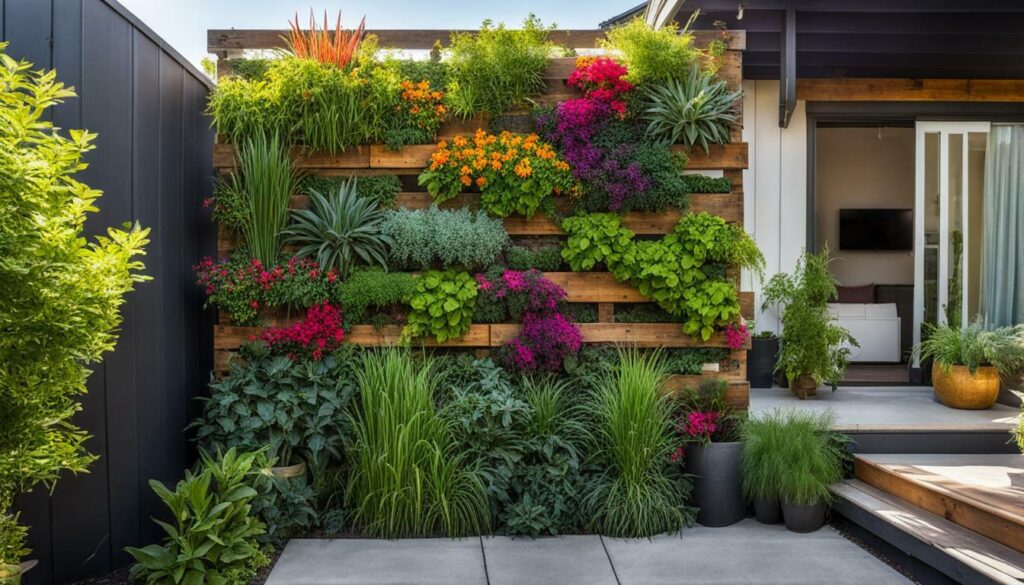
Repurposing a wooden pallet as a vertical garden on a fence is a creative and cost-effective way to add greenery to your outdoor space. Whether you choose to grow herbs, cascading flowers, or a mix of different plants, the unique texture and charm of a pallet fence plant wall will surely enhance the aesthetic appeal of your garden.
| Materials Needed | Steps |
|---|---|
| – Wooden pallet | – Staple landscaping fabric to the back, side, and bottom of the pallet |
| – Landscaping fabric | – Secure the pallet to the fence using screws or nails |
| – Screws or nails | – Fill the pallet with potting soil |
| – Potting soil | – Plant a variety of suitable plants in the pallet’s openings |
| – Plants suitable for vertical gardening | – Water the plants thoroughly after planting |
Benefits of a Repurposed Pallet Fence Plant Wall
“Repurposing a wooden pallet as a vertical garden on a fence is not only environmentally friendly but also adds a charming and rustic touch to your outdoor space.”
Repurposing a pallet as a fence plant wall offers several benefits. First, it is a sustainable and eco-friendly gardening option, as it repurposes materials that would otherwise go to waste. By using a recycled wooden pallet, you’re reducing your carbon footprint and promoting the concept of upcycling.
Second, a repurposed pallet fence plant wall adds a unique and rustic aesthetic to your outdoor space. The natural texture and character of the wood create a charming backdrop for your plants, giving your garden a distinctive look.
Furthermore, a pallet fence plant wall allows you to maximize vertical space and grow a variety of plants in a limited area. It’s an excellent solution for small yards or urban gardens where space is at a premium. By utilizing the vertical space on your fence, you can create a lush and vibrant garden without sacrificing valuable ground space.
In addition, a pallet fence plant wall provides a practical solution for organizing and displaying plants. The individual openings in the pallet allow you to plant different species in separate compartments, making it easy to care for and maintain your garden. It’s also a great way to showcase a variety of plants and create visual interest with different colors, textures, and heights.
Overall, a repurposed pallet fence plant wall is a creative and versatile option for creating a vertical garden on your fence. It offers unique aesthetic appeal, maximizes space, and provides an environmentally friendly gardening solution.
Using Metal Rods or Pipes to Suspend Hanging Baskets
For an urban and industrial look, you can use metal rods or pipes to suspend hanging baskets on your fence, creating a unique and eye-catching vertical garden. This method is not only functional but also adds a touch of modern design to your outdoor space.To get started, you will need metal rods or pipes that are sturdy enough to support the weight of the hanging baskets. You can find these at your local home improvement store or repurpose old pipes for a more sustainable option. Choose rods or pipes that are long enough to span the width of your fence and ensure they are securely attached to the fence.Once you have your metal rods or pipes in place, you can hang your baskets from them. Choose baskets that are lightweight but durable, as they will be suspended in the air. You can use wire or chain to attach the baskets to the rods or pipes, ensuring they are secure and won’t fall.To create a visually appealing fence garden decor, consider mixing different types of plants and baskets. Use a variety of colors, textures, and sizes to create an interesting and dynamic display. You can also incorporate trailing plants that will cascade down from the baskets, adding depth and visual interest to your vertical garden.Here is an example of a plant arrangement for a metal rod or pipe vertical garden:| Plant | Light Requirements | Watering Needs |
|---|---|---|
| Petunias (trailing varieties) | Full sun | Regular watering |
| Ivy Geranium | Partial sun to shade | Regular watering |
| Verbena | Full sun | Regular watering |
| Trailing Lobelia | Partial sun to shade | Regular watering |
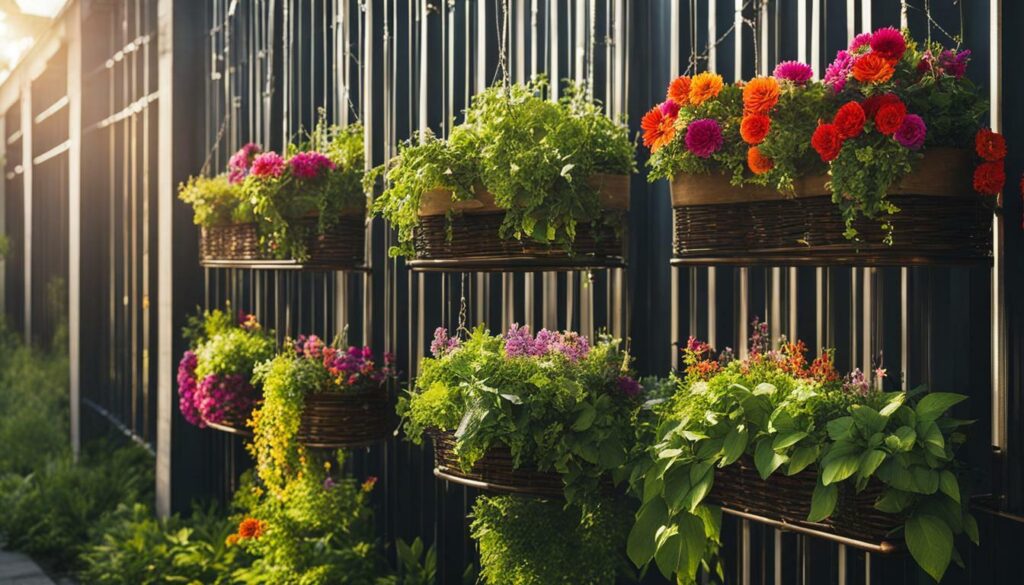 Source: [Priyanka Chopra Jonas Instagram](https://www.instagram.com/priyankachopra)
Source: [Priyanka Chopra Jonas Instagram](https://www.instagram.com/priyankachopra)Creating a Living Green Wall
Take your fence garden design to the next level by creating a living green wall. A living green wall not only enhances the aesthetic appeal of your fence but also provides a lush and vibrant backdrop for your outdoor space.
To create a living green wall on your fence, there are various options available depending on your preferences and the amount of space you have. One popular choice is to purchase a kit specifically designed for creating a living green wall. These kits typically include modular panels that can be easily attached to your fence, allowing you to easily install and maintain your vertical garden.
Another option is to create a DIY living green wall using a trellis system. Start by attaching a trellis to your fence, ensuring it is securely fastened. Then, select the plants you would like to include in your green wall. Consider choosing plants with different textures and colors to create visual interest. Attach hanging planters to the trellis or use vertical planting pockets to hold the plants. Fill the planters or pockets with a high-quality potting mix and carefully plant your chosen plants, ensuring they have enough space to grow.
Once your living green wall is established, it’s important to provide regular care and maintenance. This includes watering the plants regularly, ensuring they receive adequate sunlight, and monitoring for pests and diseases. Consider installing a drip irrigation system for easy and efficient watering. Prune and trim the plants as needed to maintain their shape and prevent overgrowth.
Benefits of a Living Green Wall
A living green wall offers numerous benefits beyond its visual appeal. Firstly, it helps to purify the air by absorbing pollutants and releasing oxygen. It also provides insulation, helping to regulate temperature and reduce energy costs. Additionally, a living green wall on your fence can act as a natural sound barrier, reducing noise pollution from neighboring properties or busy streets.
| Benefits of a Living Green Wall |
|---|
| Purifies the air by absorbing pollutants |
| Provides insulation and regulates temperature |
| Reduces noise pollution |
Whether you choose to purchase a kit or create your own DIY living green wall, incorporating this vertical garden design into your fence is a creative and eco-friendly way to enhance your outdoor space. Enjoy the beauty and tranquility of a living green wall while reaping the benefits it provides.
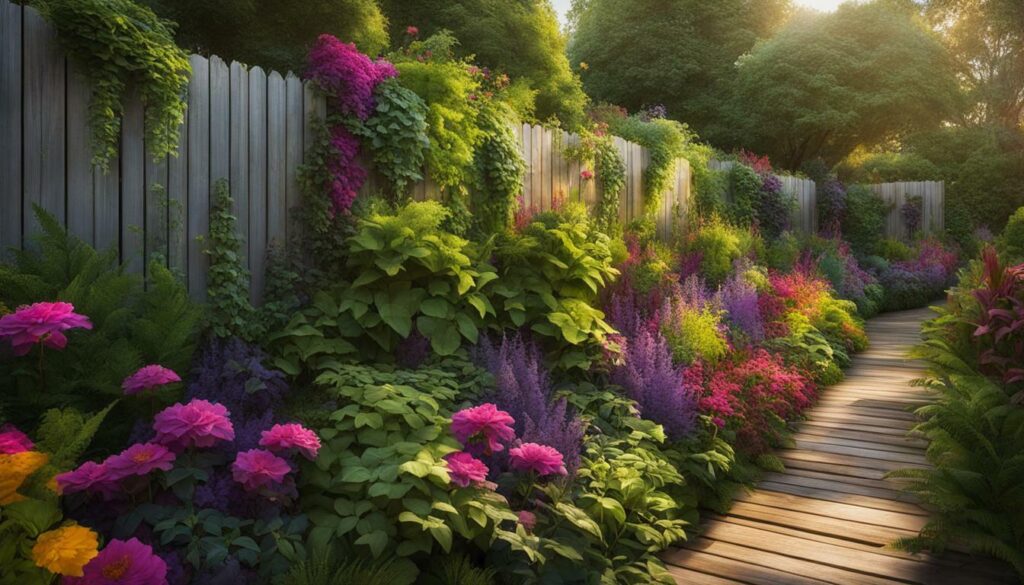
Best Plants for a Vertical Garden on a Fence
When it comes to choosing plants for your vertical garden on a fence, it’s important to consider not only their aesthetic appeal but also their suitability for growing in a vertical environment. Here is a curated list of the best plants that thrive in a fence herb garden or fence planters.
Vining Plants
1. Morning Glories (Ipomoea purpurea) – These fast-growing annual vines produce beautiful flowers in a variety of colors, making them a stunning addition to any vertical garden.
2. Clematis (Clematis spp.) – Known for their showy flowers, clematis vines add a touch of elegance to a fence. They come in a range of colors and bloom from spring to fall.
3. Scarlet Runner Beans (Phaseolus coccineus) – These vigorous climbers produce stunning red flowers and are also edible. They can be grown for both their ornamental value and for their tasty beans.
| Plant | Benefits |
|---|---|
| Morning Glories | Fast-growing, stunning flowers |
| Clematis | Showy flowers, range of colors |
| Scarlet Runner Beans | Edible, attractive red flowers |
4. Squash (Cucurbita spp.) – If you want to make the most of your vertical space and enjoy a plentiful harvest, grow climbing varieties of squash. They produce large, colorful fruits and are a great choice for fence planters.
5. Climbing Roses (Rosa spp.) – For a touch of romance and fragrance, consider planting climbing roses on your fence. They come in a variety of colors and will add beauty and elegance to your vertical garden.
6. Boston Ivy (Parthenocissus tricuspidata) – This vigorous, deciduous vine is known for its stunning fall foliage. It will quickly cover a fence and provide a dramatic backdrop for your garden.
Herbs
1. Basil (Ocimum basilicum) – A versatile and aromatic herb, basil is a great choice for a fence herb garden. It can be used in a variety of dishes, from Italian cuisine to cocktails.
2. Mint (Mentha spp.) – Mint is a hardy herb that can tolerate partial shade, making it a perfect choice for a fence garden. It can be used to make refreshing teas, cocktails, and desserts.
3. Thyme (Thymus spp.) – With its small, fragrant leaves, thyme is an excellent choice for a fence herb garden. It can be used in a variety of culinary dishes and is also a beautiful ornamental plant.
- Basil
- Mint
- Thyme
4. Rosemary (Rosmarinus officinalis) – This aromatic herb is a popular choice for fence herb gardens. It has a strong flavor and can be used in a variety of dishes, from roasted meats to savory breads.
5. Chives (Allium schoenoprasum) – Chives are a hardy herb that can be grown in a fence herb garden. They can be used to add a mild onion flavor to salads, soups, and other dishes.
6. Parsley (Petroselinum crispum) – With its vibrant green leaves, parsley is a beautiful addition to a fence herb garden. It can be used as a garnish or added to a variety of dishes for its fresh flavor.
“A vertical garden on a fence provides the perfect opportunity to grow a variety of plants, from vining flowers to herbs. By choosing the right plants for your vertical garden, you can create a stunning and productive space that will enhance the beauty of your outdoor area.”
When selecting plants for your vertical garden on a fence, consider their sunlight and water requirements, as well as their growth habits. Choose plants that will thrive in the specific conditions of your garden to ensure their success.
Flowering Plants
1. Petunias (Petunia spp.) – These popular annual flowers come in a wide range of colors and are perfect for adding a pop of color to your vertical garden.
2. Geraniums (Pelargonium spp.) – Known for their vibrant blooms, geraniums are a classic choice for fence planters. They are low-maintenance and can tolerate a variety of growing conditions.
3. Nasturtiums (Tropaeolum majus) – These edible flowers are not only beautiful but also add a peppery flavor to salads and other dishes. They can be grown in hanging baskets or planters attached to a fence.
- Petunias
- Geraniums
- Nasturtiums
4. Lantana (Lantana camara) – With its clusters of vibrant flowers, lantana is a great choice for a fence plant wall. It attracts butterflies and hummingbirds and adds a splash of color to your outdoor space.
5. Black-Eyed Susans (Rudbeckia hirta) – These cheerful, daisy-like flowers bloom from summer to fall and are a great choice for a vertical garden on a fence. They attract pollinators and add a touch of wild beauty to any garden.
6. Sweet Alyssum (Lobularia maritima) – This low-growing, fragrant flower is perfect for planting in hanging baskets or planters attached to a fence. It cascades beautifully and adds a delicate touch to your vertical garden.
Vegetables
1. Lettuce (Lactuca spp.) – Leafy greens like lettuce are perfect for a fence garden. They can be grown in hanging baskets or planters and provide a fresh supply of salad greens throughout the season.
2. Swiss Chard (Beta vulgaris) – This colorful leafy green is both beautiful and delicious. It can be grown in a fence herb garden or planters and adds a vibrant touch to any vertical garden.
3. Cherry Tomatoes (Solanum lycopersicum) – These small, sweet tomatoes are perfect for growing in a fence garden. They can be grown in hanging baskets or planters and provide a bountiful harvest throughout the season.
- Lettuce
- Swiss Chard
- Cherry Tomatoes
4. Peppers (Capsicum spp.) – Whether you prefer sweet or spicy, peppers are a great choice for a fence vegetable garden. They can be grown in hanging baskets or planters and add a burst of flavor to your meals.
5. Beans (Phaseolus spp.) – Both pole beans and bush beans can be grown in a vertical garden on a fence. They provide a plentiful harvest and are easy to grow, making them a great choice for beginners.
6. Cucumbers (Cucumis sativus) – These refreshing vegetables are perfect for a fence garden. They can be grown in hanging baskets or planters and add a crisp texture to salads and sandwiches.
By choosing the right plants for your vertical garden on a fence, you can create a stunning and productive space that will enhance the beauty of your outdoor area. Experiment with different plant combinations to create a unique and personalized vertical garden that reflects your style and taste.
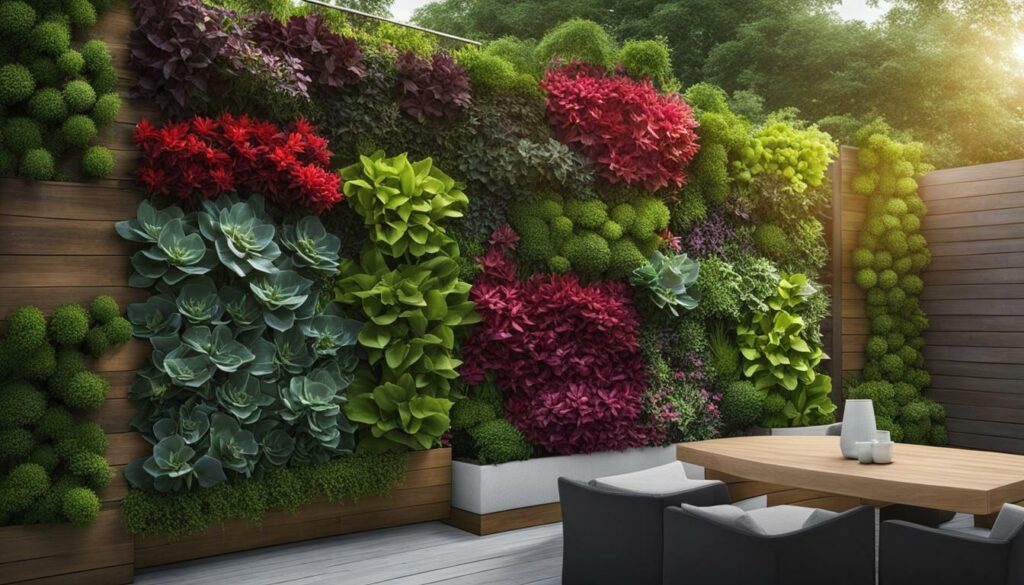
Maintaining a Vertical Garden on a Fence
To ensure the longevity and health of your vertical garden on a fence, proper maintenance is key. In this section, we will explore essential tips and techniques for maintaining a vibrant and thriving fence garden design. Taking care of your vertical garden will not only ensure its beauty but also maximize its productivity and lifespan.
Watering
Watering is crucial for the health of your plants in a vertical garden on a fence. As plants are growing vertically, they may require more frequent watering than traditional gardens. It’s important to regularly check the moisture level in the soil and water accordingly. Consider using a drip irrigation system or self-watering planters to provide a consistent water supply. This will help prevent overwatering or underwatering and ensure that your plants thrive.
Fertilizing
Fertilizing is essential to keep your plants healthy and promote their growth. Choose a balanced fertilizer that is suitable for the types of plants in your vertical garden. Follow the instructions on the fertilizer packaging for the correct dosage and application frequency. Be mindful of not over-fertilizing, as it can lead to nutrient build-up and harm your plants. Regularly monitor the foliage for signs of nutrient deficiencies, such as yellowing leaves or stunted growth, and adjust your fertilizer regime accordingly.
Pruning
Pruning is necessary to maintain the shape and size of your plants in a vertical garden on a fence. Remove any dead, damaged, or diseased foliage to prevent the spread of diseases and improve air circulation. Trim back excessive growth or unruly branches to keep your vertical garden neat and tidy. Pruning also encourages new growth and helps plants maintain their shape. Use clean and sharp pruners to make clean cuts and minimize the risk of infection.
Pest Control
Regularly inspect your plants for signs of pests and take swift action to control any infestations. Common garden pests, such as aphids, spider mites, and slugs, can cause damage to your vertical garden. Use organic pest control methods whenever possible, such as handpicking pests, applying insecticidal soap or neem oil, or introducing beneficial insects. It’s important to regularly monitor your plants and intervene early at the first sign of pest activity to minimize damage.
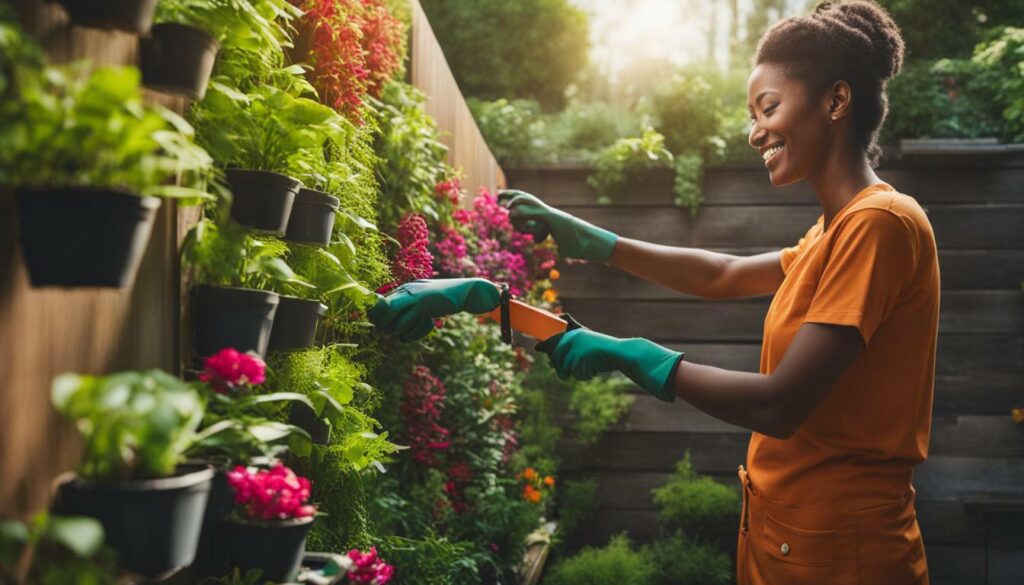
| Essential Tips for Maintaining a Vertical Garden on a Fence |
|---|
| Regularly check the moisture level and water your plants accordingly, using a drip irrigation system or self-watering planters. |
| Use a balanced fertilizer and follow the instructions for dosage and application frequency. |
| Prune dead, damaged, or unruly foliage to maintain the shape and health of your plants. |
| Monitor for pests and take immediate action to control infestations using organic methods whenever possible. |
Design Tips for a Vertical Garden on a Fence
Designing a vertical garden on a fence requires thoughtful consideration of various elements to create a visually stunning and harmonious space. Here are some design tips to help you achieve a cohesive and captivating fence garden decor:
- Color Coordination: Choose plants with complementary colors to create an eye-catching display. Consider the colors of your fence and select plants that will enhance or contrast with the background.
- Texture Variation: Incorporate plants with different leaf shapes, sizes, and textures to add depth and interest to your vertical garden. Mix plants with large, broad leaves with those that have fine, delicate foliage.
- Layering: Create dimension by layering plants of different heights. Place taller plants at the back or in the center, and shorter plants in front. This will give your vertical garden a more natural and balanced look.
| Image | Quote |
|---|---|
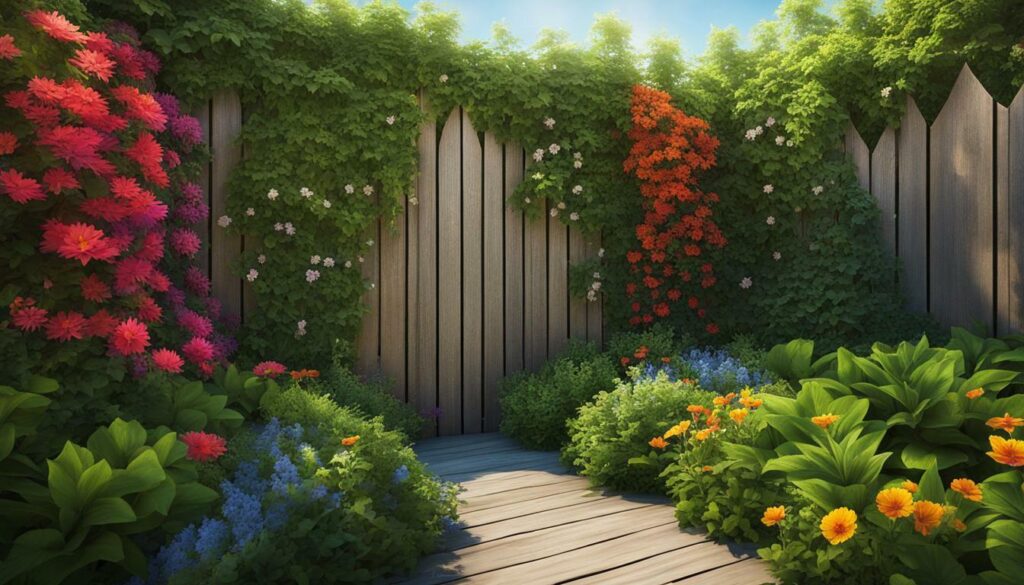 | “Designing a vertical garden on a fence requires thoughtful consideration of various elements to create a visually stunning and harmonious space.” |
Utilize decorative accents and artwork to enhance the aesthetic appeal of your vertical garden on a fence. Hang colorful wind chimes, place decorative sculptures, or include a mosaic panel for a touch of artistic flair. These elements will not only add visual interest but also create a unique and personalized fence garden decor.
Optimizing Space:
Make the most of your vertical garden by maximizing the use of available space. Utilize hanging baskets to add greenery to areas that are not typically used, such as fences corners or the space above eye level. Hanging baskets can be planted with trailing and cascading plants to create a stunning visual effect.
Remember to regularly prune and maintain your vertical garden on a fence to ensure its beauty and health. Regularly trim back overgrown plants and remove any dead or dying foliage. This will help keep your vertical garden looking tidy and prevent overcrowding.
By following these design tips, you can create a vibrant and visually appealing vertical garden on a fence that will transform your outdoor space into a stunning oasis. Let your creativity and personal style shine through as you design and customize your own fence garden decor.
Can a Vertical Garden Trellis be Used on a Fence for the Same Effect?
Yes, a vertical garden trellis can be used on a fence for the same effect to enhance outdoor space with vertical garden trellis. By attaching the trellis to the fence, you can create a beautiful vertical garden that adds greenery and charm to any outdoor area.
Conclusion
Creating a vibrant vertical garden on a fence is a rewarding and creative endeavor that can transform your outdoor space into a lush and captivating oasis. By utilizing the techniques and ideas discussed in this expert guide, you can take your fence garden design to new heights and enjoy the beauty and benefits of a vertical garden.
Whether you choose to build a trellis, install planters, attach a repurposed pallet, use metal rods or pipes, or create a living green wall, there are endless possibilities for creating a stunning and functional vertical garden on your fence. Each method offers its own unique charm and allows you to showcase your favorite plants in a vertical display.
Maintaining your vertical garden is key to its success. Proper watering, fertilizing, pruning, and pest control are essential for the health and vitality of your plants. Consider utilizing a watering system for ease and efficiency, especially if you have a large vertical garden on your fence.
When designing your vertical garden, remember to pay attention to color, texture, and plant selection to create a visually appealing and cohesive design. Incorporate unique elements like artwork or decorative accents to add personal touches to your fence garden decor.
In conclusion, creating a vibrant vertical garden on a fence is a wonderful way to maximize your gardening space and enhance the beauty of your outdoor area. Whether you have a small backyard or a large garden, there are plenty of options to suit your needs and preferences. So unleash your creativity and experiment with different techniques and plant choices to create a truly personalized and stunning fence garden.
FAQQ: What are the benefits of creating a vertical garden on a fence? A: Creating a vertical garden on a fence allows you to maximize your garden space, adds visual interest to your outdoor space, and provides privacy. It also helps to improve air quality and can even reduce noise pollution.Q: How do I build a trellis on the fence? A: To build a trellis on the fence, you can start by screwing eyes into the fence in vertical parallel columns. Then, weave heavy-duty twine or wire through the eyes to create a lattice for your plants to grow up. Finally, plant your seeds or plants at the base of the trellis and train them to grow upwards.Q: What are the best plants for a vertical garden on a fence? A: Some of the best plants for a vertical garden on a fence include roses, clematis, morning glories, runner beans, squash, cucumbers, Boston ivy, and climbing hydrangea. These plants are suited for growing vertically and can add beauty to your fence.Q: How do I maintain a vertical garden on a fence? A: To maintain a vertical garden on a fence, it’s important to water the plants regularly, fertilize as needed, prune any overgrowth, and monitor for pests. You can also consider using a watering system to make maintenance easier.Q: What design tips should I keep in mind for a vertical garden on a fence? A: When designing a vertical garden on a fence, consider the colors and textures of the plants you choose, as well as their growth habits. Incorporate unique elements like artwork or decorative accents to enhance the visual appeal of your fence garden.Q: How can I create a living green wall on a fence? A: To create a living green wall on a fence, you can purchase a kit specifically designed for this purpose and hang it on your fence. There are various options available depending on the amount of plants, design concept, and budget.Q: What are some DIY ideas for a vertical garden on a fence? A: Some DIY ideas for a vertical garden on a fence include repurposing a wooden pallet, using metal rods or pipes to suspend hanging baskets, and attaching planters directly to the fence. These creative options can add uniqueness to your fence garden.Q: How do I choose the right plants for my vertical garden on a fence? A: When choosing plants for a vertical garden on a fence, consider their growth habits, light requirements, and water needs. Select plants that are well-suited for vertical growth and can thrive in your specific climate.Q: What are some maintenance tips for a vertical garden on a fence? A: To maintain a vertical garden on a fence, ensure regular watering, fertilize as needed, prune to maintain shape and promote growth, and monitor for pests and diseases. Consider using a watering system to simplify maintenance.Q: How can I make my vertical garden on a fence visually appealing? A: To make your vertical garden on a fence visually appealing, consider the colors, textures, and heights of the plants you choose. Incorporate decorative elements like artwork or accents to enhance the overall aesthetic of your fence garden.Q: Is it possible to create a vertical garden on a fence with limited space? A: Yes, creating a vertical garden on a fence is an excellent option for utilizing limited space. It allows you to maximize your vertical space while still enjoying the benefits of gardening.
